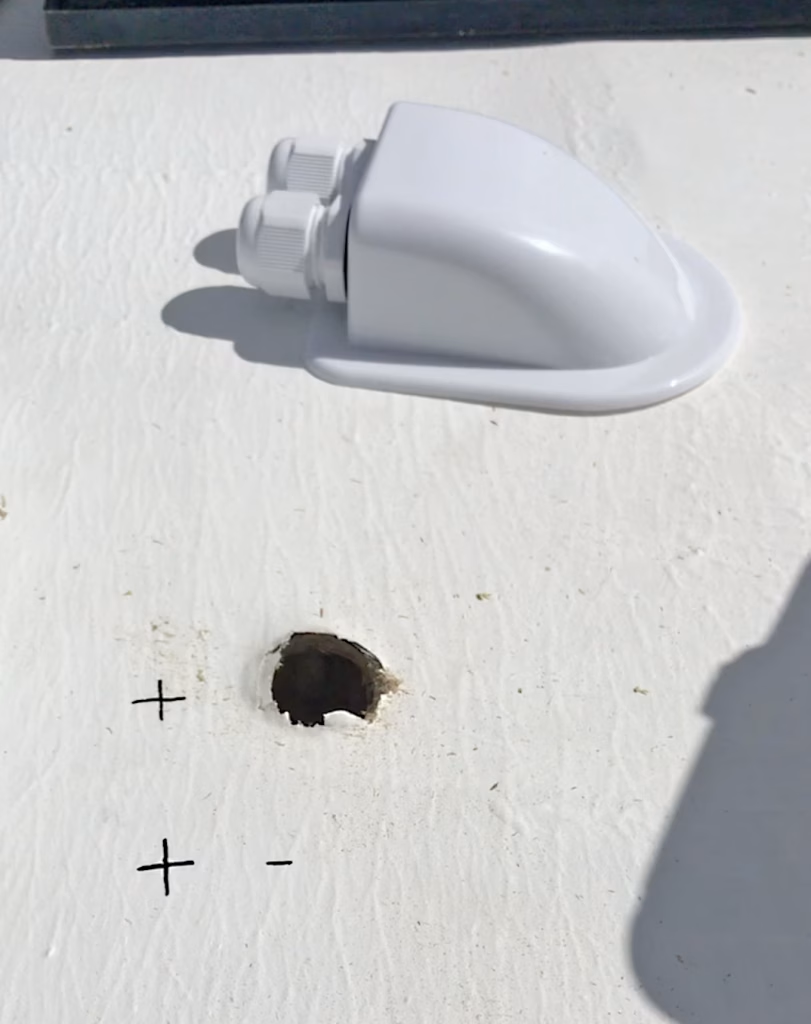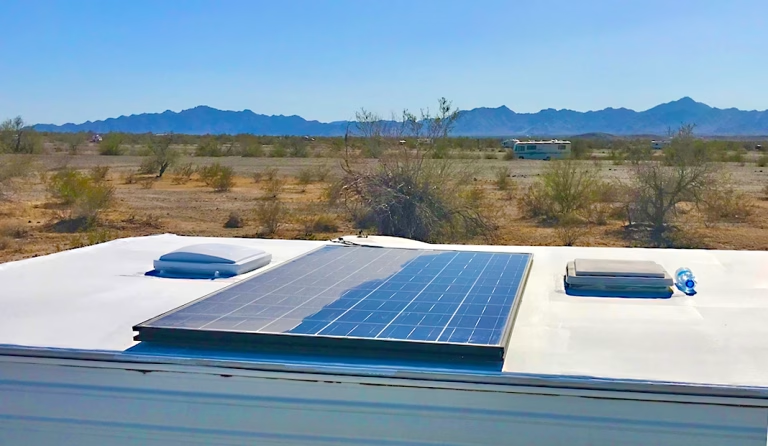Solar Power for RV Tips: Real World Advice from an Experienced RVer
This post may contain affiliate links.
After seven years of nomadic living, RV owner Stormy Shafer has installed and used RV solar power systems in three different rigs. Her experience has taught her that while the learning curve can feel steep, it’s worth it for the freedom and reliability a well-designed solar setup can offer. In this article, Stormy shares five practical tips for RVers who want to take advantage of solar power.
Want a deeper dive into solar system design and installation? Check out Stormy’s in-depth guide to RV solar installation.
1. Don’t Skip the Homework
Stormy was lucky enough to pay an electrician for her first install, but she quickly realized how much easier the process becomes when you actually understand the system you’re building.
“I did try to learn as much as I could before I got on the road, but that was back in 2018-19, when there was far less accurate or easily accessible information on the Web… These days, there are countless videos and websites you can consult, with confidence that they’re telling you the right stuff.”
Whether you’re installing your system yourself or hiring someone else, knowing the basics helps you avoid wasting money on the wrong components—or getting talked into things you don’t need.
2. Calculate Your Real Energy Needs
One of the most common mistakes new RVers make is underestimating how much power they actually use. Stormy advises doing the math—even if it’s a pain.
“There’s nothing worse than getting your system all set up, only to realize you forgot to make allowances for something important because you just didn’t want to take the time to plan well.
This kind of neglect would go under my road mantra: Don’t be stupid. Seriously, you’ll only have to do this once or twice in your life on the road, so don’t shoot yourself in the foot by being lazy. Do the math, even if it takes you some time. It won’t hurt you to flex that brain a bit.”
Read Stormy’s step-by-step process for calculating your solar power needs here: How Much Solar Do I Need for My RV? 5 Steps to Know for Sure
3. Watch for Deals to Stretch Your Budget
Track Down Used Parts to Stretch Your Budget
If money is tight, Stormy suggests watching for gently used components and trusted mid-range brands.
“You can buy [rigid panels] used for roughly 25 cents per watt, many still carrying 10-20 year warranties… I don’t need brand name, but I do pay close attention to the reviews. No reviews, no sale—this is too important a purchase.”
A little bargain hunting can help you build a solid system at a fraction of the cost—especially if you’re willing to install it yourself.
To get an idea of what your solar setup will cost, read this article: RV Solar Installation Cost: What You’ll Pay for a Basic RV Solar Power System
4. Don’t Fear the Drill (Too Much)
Stormy has roof-mounted solar panels on multiple rigs, and yes, that means drilling holes in your RV roof. It sounds scary, but it doesn’t have to be.
“That freaks a lot of folks out, but I’ve done it three times, and if you take your time and do it right, you really don’t have to worry about leaks. Mine never leaked, but I also went up on the roof for a close inspection at the end of every winter season.”
Drilling through your roof allows for cleaner installations and better sun exposure. Just be sure to seal things properly and perform regular maintenance.

5. Prep Your Roof Before Installing Panels
Stormy recommends inspecting and resealing your RV’s roof before installing solar panels—especially if you’re moving a system from one rig to another.
“I made sure to get up there…to thoroughly clean and reseal the roof membrane. That way, I knew I was starting with a monolithic surface with no cracks… If any leaks were to occur later, I knew it would mean I had to look at the solar panel install.”
Doing this prep work gives you peace of mind and makes troubleshooting easier later on.
6. Keep Your Panels Clean—It Really Matters
Dust buildup on solar panels can cut their efficiency in half, especially in dry, windy climates.
“That half that hasn’t been wiped off yet is probably only working at about 50% efficiency… I usually get up there at least once a month and sometimes every two weeks.”
Stormy uses a basic window-washing tool with no soap—just water—to clean her panels quickly and safely.
7. Use the Microwave Cubby for Clean Cable Routing
To keep wiring tidy and out of the way, Stormy ran her solar panel cables through the roof into the empty space behind her microwave.
“Not only was there a good bit of unused room available there, it also led directly down to the space below, where I located the charge controller.”
Planning your cable routes in advance can make installation smoother and help you avoid unnecessary holes.
8. Keep Cable Runs Short When You Can
Stormy points out that long cable runs create friction, which reduces efficiency—so shorter is always better when possible.
“Make [the cable run] as short a run as possible to avoid power loss from friction… Stranded wire is generally preferred for solar panel wiring, especially in mobile systems where flexibility is important.”
If you do need longer runs, use thicker cable (like 6 AWG) to reduce resistance. And opt for stranded wire, which holds up better to the movement and vibration of life on the road.
9. Label Your Wires—Future You Will Thank You
Once your system is wired and running, take the time to organize and label everything.
“I strongly recommend taking some time…to clean up the spaghetti into neat bundles, and label them. You will thank yourself the next time you need to do some maintenance.”
Even a simple masking tape and marker system can save you headaches during upgrades or repairs.
10. Leverage the Experience of the RV Community
Stormy recommends checking out annual events like Van Aid in Quartzsite, Arizona, where experienced RVers help others install and troubleshoot solar systems.
“These amazing events… are one of the most tangible expressions of the caring nature of most RV dwellers. People who need things for their rig builds get together and trade either time or money for help… I traded my marketing services for the system upgrade help.”
In addition to a helping hand, you might find people giving away or selling used components on the cheap—and maybe even willing to barter for your skills or labor.
Final Thoughts
RV solar power doesn’t have to be intimidating. With a little research and the right mindset, you can build a system that gives you the independence to camp anywhere the sun shines. For more technical guidance, including system components, setup options, and cost breakdowns, read Stormy’s complete beginner’s guide to RV solar.
Ashley Mann founded RVinspiration.com in 2017. She handed off the website to new owners in 2022 to launch a new business as an online entrepreneur coach, but she still helps out as the blog editor. Ashley spent three years living full time in a 38-foot, 5th-wheel RV with her husband Josiah and their cat, Kitty. Her favorite thing about RV life is the challenge of finding the perfect way to organize a space, and she loves seeing all the creative and clever ways people come up with to customize their RVs.





